lock HONDA CIVIC HATCHBACK 2003 7.G Repair Manual
[x] Cancel search | Manufacturer: HONDA, Model Year: 2003, Model line: CIVIC HATCHBACK, Model: HONDA CIVIC HATCHBACK 2003 7.GPages: 275, PDF Size: 6.75 MB
Page 203 of 275
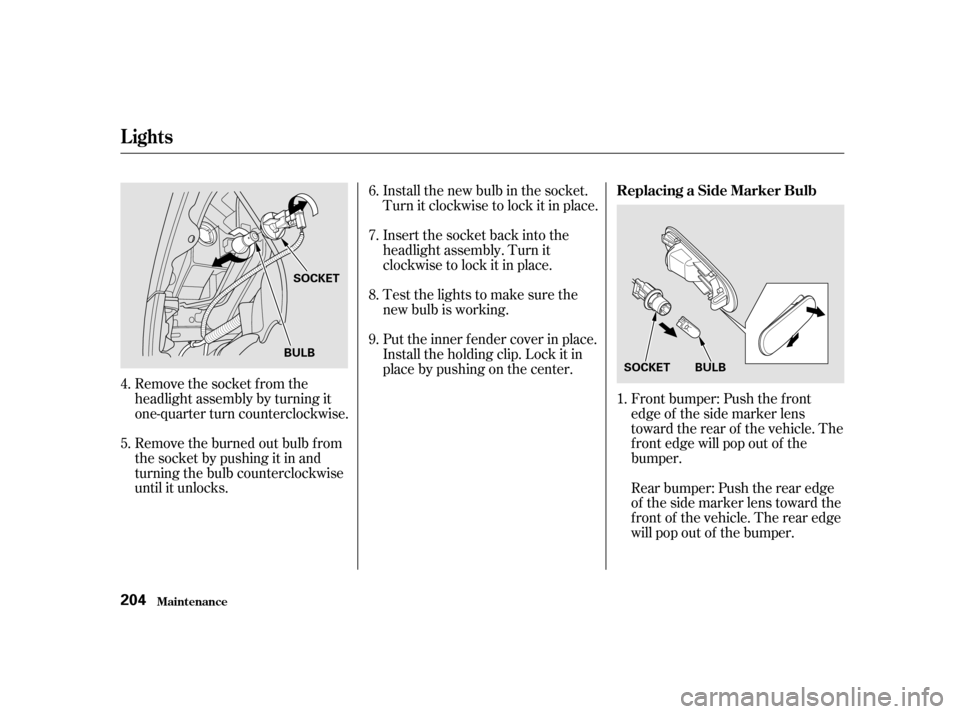
Remove the socket from the
headlight assembly by turning it
one-quarter turn counterclockwise.
Remove the burned out bulb f rom
thesocketbypushingitinand
turning the bulb counterclockwise
until it unlocks.Install the new bulb in the socket.
Turn it clockwise to lock it in place.
Insert the socket back into the
headlight assembly. Turn it
clockwise to lock it in place.
Testthelightstomakesurethe
new bulb is working.
Put the inner f ender cover in place.
Install the holding clip. Lock it in
placebypushingonthecenter.
Front bumper: Push the f ront
edge of the side marker lens
toward the rear of the vehicle. The
f ront edge will pop out of the
bumper.
Rear bumper: Push the rear edge
of thesidemarkerlenstowardthe
f ront of the vehicle. The rear edge
will pop out of the bumper.
4. 5. 6. 7. 8. 9.
1.
Replacing a Side Marker Bulb
Lights
Maint enance
204 SOCKET
BULB BULB
SOCKET
Page 204 of 275
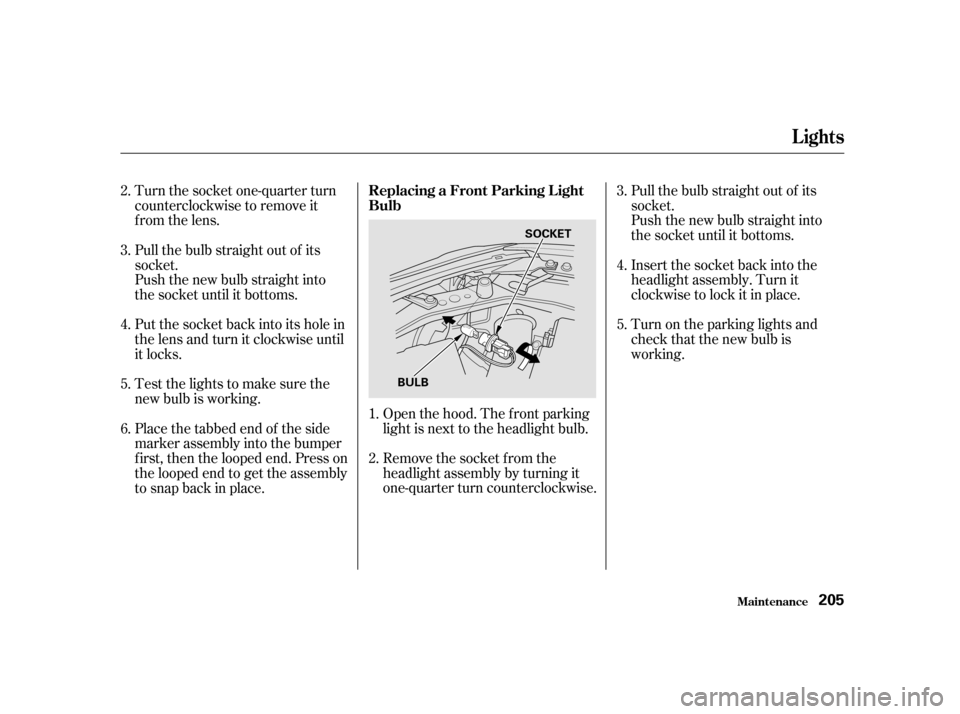
Open the hood. The f ront parking
light is next to the headlight bulb.
Remove the socket from the
headlight assembly by turning it
one-quarter turn counterclockwise.Pull the bulb straight out of its
socket.
Push the new bulb straight into
the socket until it bottoms.
Insert the socket back into the
headlight assembly. Turn it
clockwise to lock it in place.
Place the tabbed end of the side
marker assembly into the bumper
f irst, then the looped end. Press on
the looped end to get the assembly
to snap back in place.
Testthelightstomakesurethe
new bulb is working.
Put the socket back into its hole in
the lens and turn it clockwise until
it locks.
Push the new bulb straight into
the socket until it bottoms.
Pull the bulb straight out of its
socket.
Turn the socket one-quarter turn
counterclockwise to remove it
from the lens.
Turn on the parking lights and
check that the new bulb is
working.
1. 2. 3. 4. 5.
3. 4. 5. 6.
2.
Replacing a Front Parking L ight Bulb
Lights
Maint enance205
BULB
SOCKET
Page 205 of 275
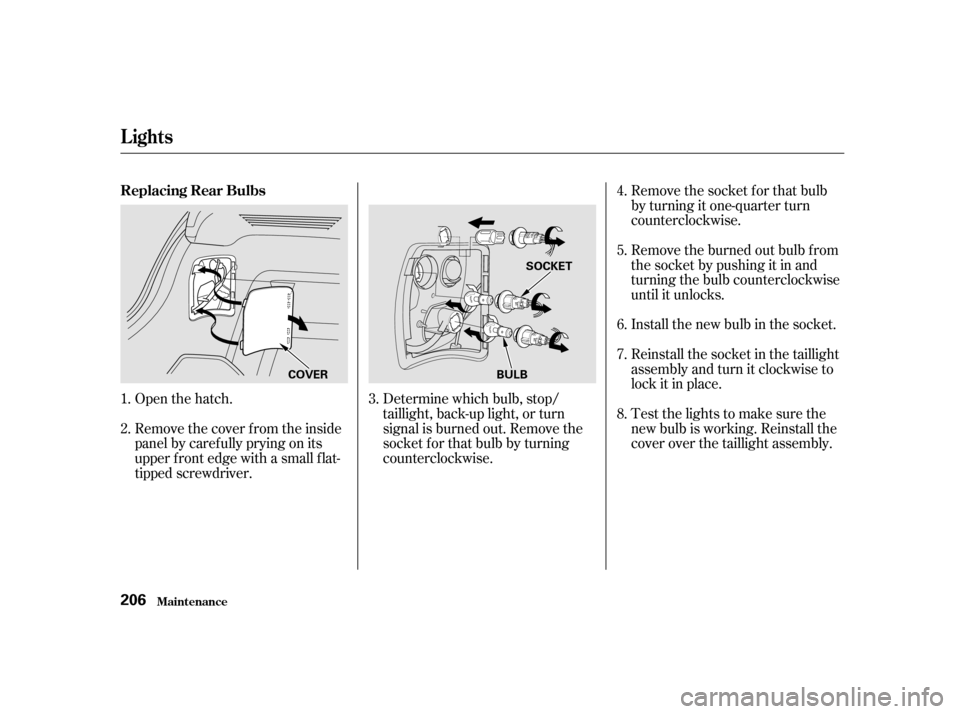
Open the hatch.Remove the socket f or that bulb
by turning it one-quarter turn
counterclockwise.
Remove the burned out bulb f rom
thesocketbypushingitinand
turning the bulb counterclockwise
until it unlocks.
Install the new bulb in the socket.
Testthelightstomakesurethe
new bulb is working. Reinstall the
cover over the taillight assembly.
Remove the cover f rom the inside
panel by caref ully prying on its
upper f ront edge with a small f lat-
tipped screwdriver. Reinstall the socket in the taillight
assembly and turn it clockwise to
lock it in place.
Determine which bulb, stop/
taillight, back-up light, or turn
signal is burned out. Remove the
socket f or that bulb by turning
counterclockwise.
1.
3.
2. 4. 5. 6. 7. 8.
Replacing Rear Bulbs
Lights
Maint enance
206 COVER BULB
SOCKET
Page 207 of 275
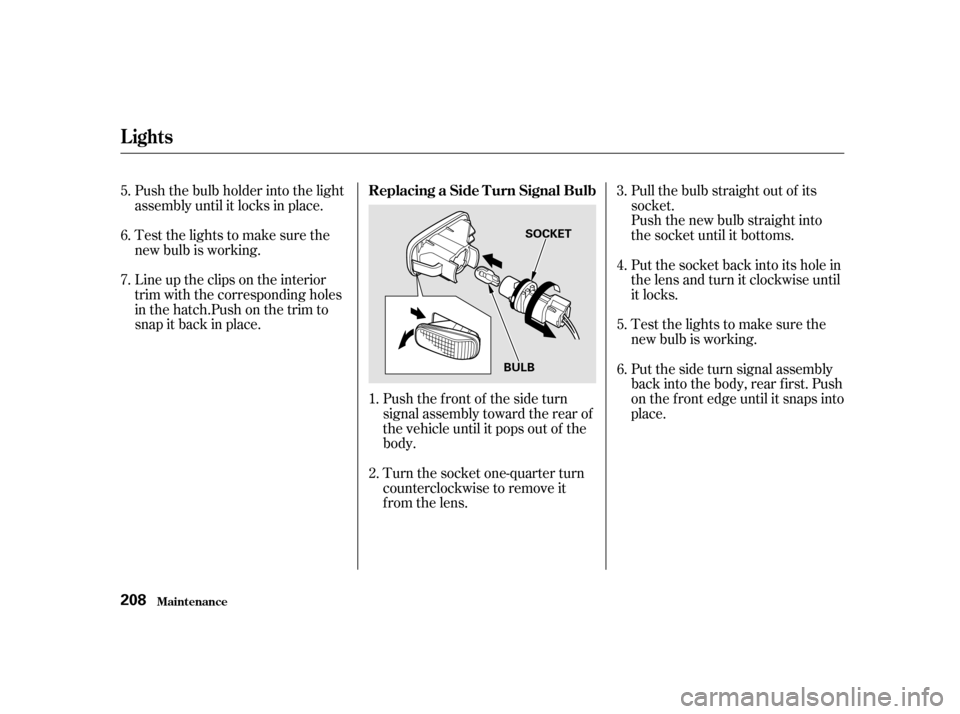
Push the new bulb straight into
the socket until it bottoms.
Pull the bulb straight out of its
socket.
Put the socket back into its hole in
the lens and turn it clockwise until
it locks.
Put the side turn signal assembly
back into the body, rear first. Push
on the f ront edge until it snaps into
place.
Push the bulb holder into the light
assembly until it locks in place.
Testthelightstomakesurethe
new bulb is working.
Testthelightstomakesurethe
new bulb is working.
Line up the clips on the interior
trim with the corresponding holes
in the hatch.Push on the trim to
snap it back in place.
Pushthefrontof thesideturn
signal assembly toward the rear of
the vehicle until it pops out of the
body.
Turn the socket one-quarter turn
counterclockwise to remove it
from the lens.
1.
2. 3. 5. 6.
4.
6.7.
5.
Replacing a Side T urn Signal Bulb
Maint enance
Lights
208 BULB
SOCKET
Page 211 of 275

Block the rear wheels.
Fill the f uel tank.
Change the engine oil and f ilter
(see page ).
Wash and dry the exterior
completely.
Cleantheinterior.Makesurethe
carpeting, floor mats, etc. are
completely dry.
If you need to park your car f or an
extended period (more than one
month), there are several things you
should do to prepare it f or storage.
Proper preparation helps prevent
deterioration and makes it easier to
get your car back on the road. If
possible, store your car indoors.
If the car is to be stored for a
longer period, it should be
supported on jackstands so the
tires are of f the ground.
Leave one window open slightly (if
the car is being stored indoors).Coverthecarwitha‘‘breathable’’
cover, one made f rom a porous
material such as cotton.
Nonporous materials, such as
plastic sheeting, trap moisture,
which can damage the paint.
Disconnect the battery.
Support the f ront and rear wiper
blade arms with a f olded towel or
ragsotheydonottouchthe
windshield.
To minimize sticking, apply a
silicone spray lubricant to all door
and hatch seals. Also, apply a body
wax to the painted surf aces that
mate with the door and hatch seals. If possible, run the engine f or a
while periodically (pref erably once
amonth).
If you store your car f or 12 months
or longer, have your Honda dealer
perf orm the inspections called f or in
the 24 months/30,000 miles (48,000
km) maintenance schedule (Normal
Conditions) as soon as you take it
out of storage (see page ). The
replacements called f or in the
maintenance schedule are not
needed unless the car has actually
reached that time or mileage.
Leave the parking brake off. Put
the transmission in Reverse. 158
169
St oring Your Car
Maint enance
212
Page 222 of 275
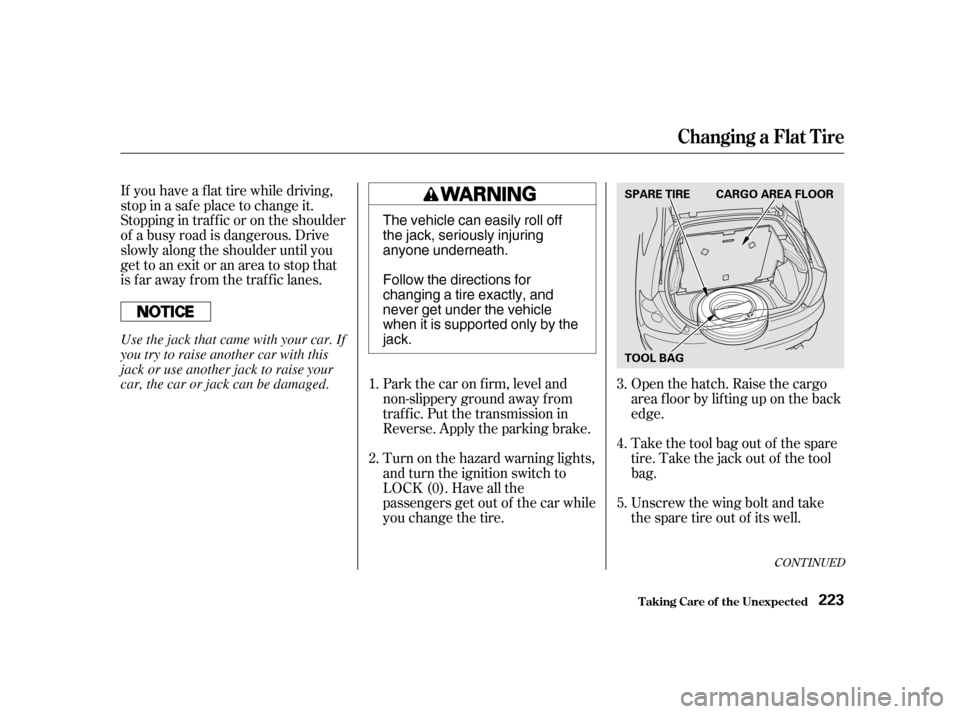
If you have a f lat tire while driving,
stop in a saf e place to change it.
Stopping in traf f ic or on the shoulder
of a busy road is dangerous. Drive
slowly along the shoulder until you
gettoanexitoranareatostopthat
is far away from the traffic lanes.Open the hatch. Raise the cargo
area floor by lifting up on the back
edge.
Unscrew the wing bolt and take
the spare tire out of its well.
Take the tool bag out of the spare
tire. Take the jack out of the tool
bag.
Turn on the hazard warning lights,
and turn the ignition switch to
LOCK (0). Have all the
passengers get out of the car while
you change the tire.
Park the car on f irm, level and
non-slippery ground away f rom
traf f ic. Put the transmission in
Reverse. Apply the parking brake.
2. 3.
1.
4. 5.
CONT INUED
Changing a Flat T ire
T aking Care of t he Unexpect ed223
SPARE TIRE CARGO AREA FLOOR
TOOL BAG
The vehicle can easily roll off
the jack, seriously injuring
anyone underneath.
Follow the directions for
changing a tire exactly, and
never get under the vehicle
when it is supported only by thejack.
Use the jack that came with your car. If
you try to raise another car with this
jack or use another jack to raise your
car, the car or jack can be damaged.
Page 223 of 275
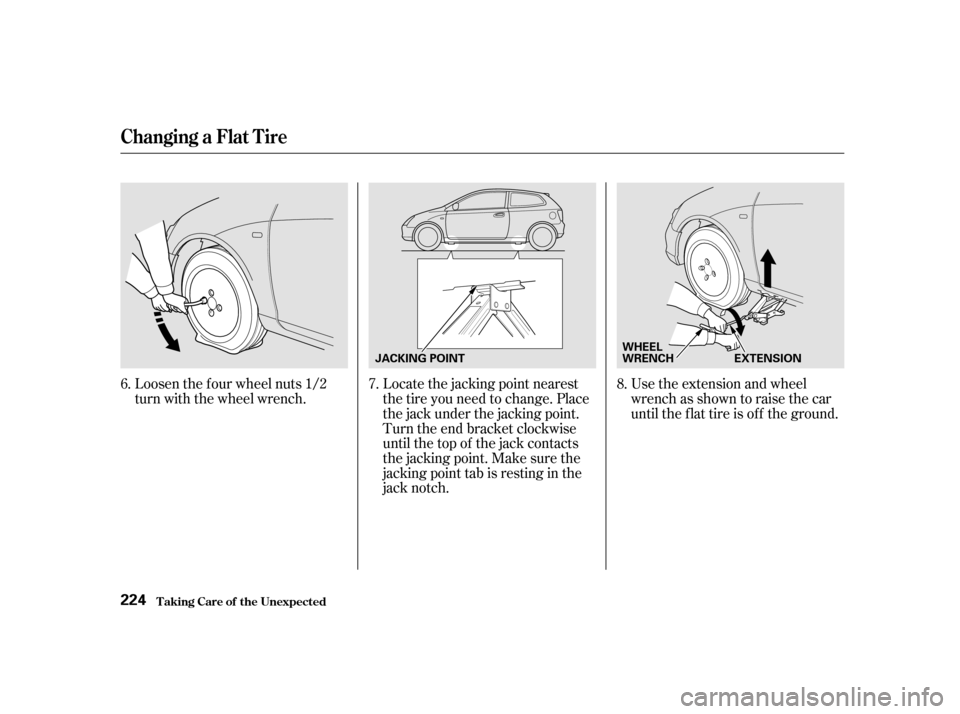
Locate the jacking point nearest
thetireyouneedtochange.Place
the jack under the jacking point.
Turn the end bracket clockwise
until the top of the jack contacts
the jacking point. Make sure the
jacking point tab is resting in the
jack notch.
Loosen the f our wheel nuts 1/2
turn with the wheel wrench.
Use the extension and wheel
wrench as shown to raise the car
until the f lat tire is of f the ground.
6.
7.8.
T aking Care of t he Unexpect ed
Changing a Flat T ire
224 JACKING POINT
WHEEL
WRENCH EXTENSION
Page 227 of 275

Diagnosing why your engine won’t
start f alls into two areas, depending
on what you hear when you turn the
key to START (III):You hear nothing, or almost
nothing. The engine’s starter
motor does not operate at all, or
operates very slowly.
You can hear the starter motor
operating normally, or the starter
motor sounds like it is spinning
f aster than normal, but the engine
does not start up and run. When you turn the ignition switch to
START (III), you do not hear the
normal noise of the engine trying to
start. You may hear a clicking sound
or series of clicks, or nothing at all.
Check these things:
Check the transmission interlock.
The clutch pedal must be pushed
all the way to the f loor or the
starter will not operate.
Turn the ignition switch to ON (II).
Turn on the headlights and check
their brightness. If the headlights
are very dim or don’t light at all,
the battery is discharged. See
on page .230
Nothing Happens or the Starter
Motor Operates Very Slowly
Jump Starting
T aking Care of t he Unexpect ed
If Your Engine Won’t Start
228
Page 232 of 275

If the temperature gauge stays at
the red mark, turn of f the engine.
Wait until you see no more signs
of steam or spray, then open thehood.
If you don’t f ind an obvious leak,
check the coolant level in the
radiator reserve tank (see page). If the level is below the
MIN mark, add coolant to halfway
between the MIN and MAX marks. If the temperature stays normal,
check the coolant level in the
radiator reserve tank. If it has
gone down, add coolant to the
MAX mark. Put the cap back on
tightly.
If there was no coolant in the
reserve tank, you may also have to
add coolant to the radiator. Let the
engine cool down until the pointer reaches the middle of the tempera-
ture gauge, or lower, bef ore check-
ing the radiator.
Using gloves or a large heavy
cloth, turn the radiator cap
counterclockwise, without pushing
down, to the f irst stop. This
releases any remaining pressure in
the cooling system. After the
pressure releases, push down on
the cap and turn it until it comes
off.
Start the engine and set the
temperature control dial to
maximum. Add coolant to the
radiator up to the base of the f iller
neck. If you do not have the
proper coolant mixture available,
you can add plain water.
Remember to have the cooling
system drained and ref illed with
the proper mixture as soon as you
can.
Look f or any obvious coolant leaks,
such as a split radiator hose.
Everything is still extremely hot,
so use caution. If you f ind a leak, it
must be repaired bef ore you
continue driving (see
on page ). Put the radiator cap back on
tightly. Run the engine and watch
the temperature gauge. If it goes
back to the red mark, the engine
needs repair. (See
on page .)
4. 5.
6. 7. 8. 9.10.
11.
12.
133 245
245
Emergency
Towing
Emergency
Towing
If Your Engine Overheats
T aking Care of t he Unexpect ed 233
Removing the radiator cap
while the engine is hot can
cause the coolant to spray out,
seriously scalding you.
Always let the engine and
radiator cool down before
removing the radiator cap.
Page 240 of 275
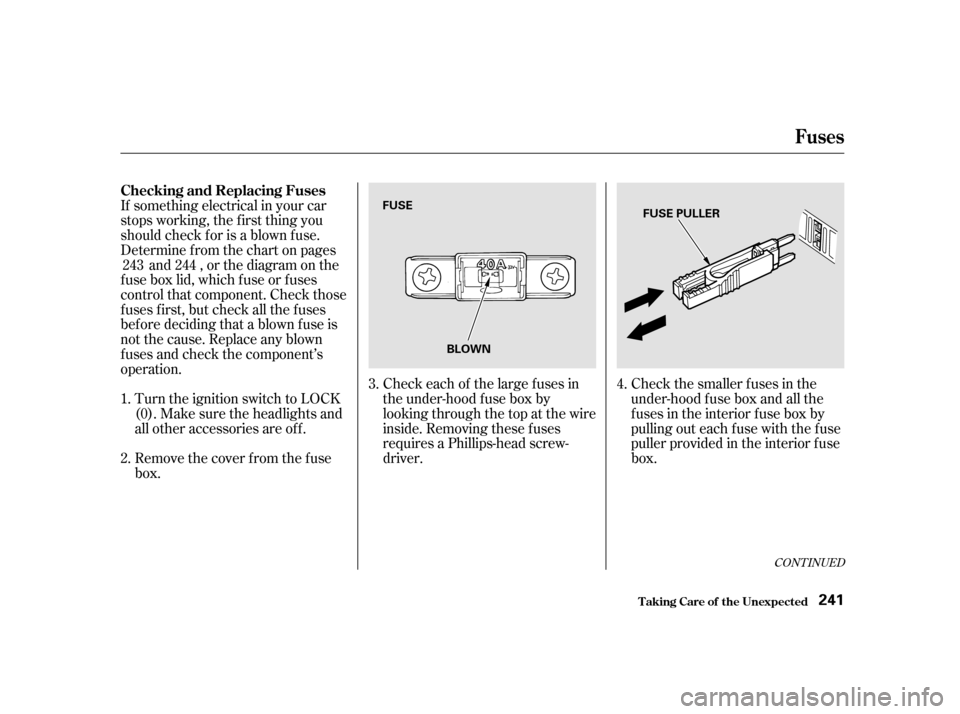
If something electrical in your car
stops working, the f irst thing you
should check f or is a blown f use.
Determine f rom the chart on pagesand , or the diagram on the
fuse box lid, which fuse or fuses
control that component. Check those
f uses f irst, but check all the f uses
bef ore deciding that a blown f use is
not the cause. Replace any blown
f uses and check the component’s
operation.
Turn the ignition switch to LOCK
(0). Make sure the headlights and
all other accessories are off.
Remove the cover f rom the f use
box. Check each of the large f uses in
the under-hood f use box by
looking through the top at the wire
inside. Removing these f uses
requires a Phillips-head screw-
driver.
Check the smaller f uses in the
under-hood f use box and all the
fuses in the interior fuse box by
pulling out each f use with the f use
puller provided in the interior f use
box.
3.
1. 2. 4.
243 244
CONT INUED
Checking and Replacing Fuses
Fuses
T aking Care of t he Unexpect ed
241
FUSE
BLOWN FUSE PULLER